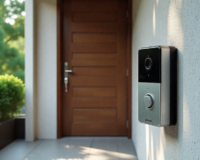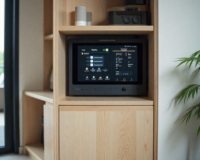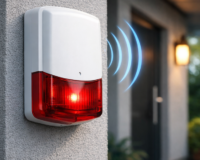Table of Contents
ToggleUnderstanding Home Automation
Home automation refers to the use of technology to control various aspects of a home, such as lighting, heating, security, and appliances, either remotely or automatically. The primary components of a home automation system include:
- Controllers: These are devices or applications that send commands to the automated systems. Controllers can be smartphones, tablets, dedicated remotes, or voice assistants like Amazon Alexa or Google Assistant.
- Actuators: These are the devices that actually control the lights, such as smart bulbs, switches, or plugs.
- Communication Protocols: These are the languages or methods through which devices communicate. Common protocols include Wi-Fi, Zigbee, Z-Wave, and Bluetooth.
- Sensors: These devices detect changes in the environment, such as motion sensors, light sensors, or occupancy sensors, and trigger actions accordingly.
Components of an Automated Lighting System
Smart Bulbs
Smart bulbs are an entry-level option for smart lighting. These bulbs can be controlled via smartphone apps or voice commands, and often include features such as dimming, color changing, and scheduling.
Smart Switches
Smart switches replace traditional wall switches and can control any standard light fixture. They allow for the integration of existing lights into a home automation system without the need to replace all the bulbs. These switches are controlled through apps, voice commands, or manually.
Smart Plugs
Smart plugs can turn any lamp into a smart lamp by controlling the power supply. They are a versatile option for lamps and other plug-in devices, allowing for remote control and scheduling.
Hubs and Bridges
Hubs and bridges are central devices that facilitate communication between different smart devices, especially when using Zigbee or Z-Wave protocols. They connect all smart lights and allow for integration with other smart home systems.
Sensors
Sensors add intelligence to lighting automation. Motion sensors can turn lights on when someone enters a room and off when they leave. Light sensors can adjust artificial lighting based on natural light levels, and occupancy sensors ensure lights are only on when the room is in use.
How Smart Switches Work
Hardware Components
A smart home light switch typically consists of the following hardware components:
- Switch Mechanism: The physical part that replaces the traditional light switch.
- Microcontroller: The brain of the switch, responsible for processing commands and controlling the switch mechanism.
- Wireless Module: Enables communication with the home network and other smart devices using Wi-Fi, Zigbee, Z-Wave, or Bluetooth.
- Power Supply: Powers the smart switch and ensures it remains connected to the network even when the lights are off.
Installation
Installing a smart light switch involves:
- Turn Off Power: Ensure the power to the switch is turned off at the circuit breaker to avoid electrical hazards.
- Remove Existing Switch: Carefully remove the existing light switch from the wall.
- Connect Wires: Connect the wires from the smart switch to the corresponding wires in the electrical box. This typically involves connecting the live, neutral, and ground wires.
- Mount the Switch: Secure the smart switch into the wall box and attach the faceplate.
- Restore Power: Turn the power back on at the circuit breaker.
Setup and Configuration
Once installed, the smart switch needs to be configured:
- Connect to Network: Use the manufacturer’s app to connect the switch to the home Wi-Fi network or relevant hub.
- App Integration: Add the switch to the app, where it can be named and assigned to specific rooms or groups.
- Customization: Set up schedules, automation routines, and integrate with voice assistants or other smart home devices.
Communication Protocols
Smart light switches communicate using various protocols, each with its advantages:
- Wi-Fi: Provides a direct connection to the home network, allowing control from anywhere with internet access. It’s widely compatible with most smart home systems.
- Zigbee and Z-Wave: These are mesh networking protocols that offer robust and reliable communication, particularly suitable for larger homes with many smart devices. They often require a hub to function.
- Bluetooth: Typically used for local control without the need for a hub, suitable for smaller setups or where remote access is less important.
Controlling Lights via Smart Switches
Using Smartphone Apps
Most smart switches come with companion apps that allow you to control your lights from your smartphone. Through these apps, you can:
- Turn Lights On/Off: Control lights individually or in groups.
- Set Schedules: Automate lights to turn on or off at specific times.
- Create Scenes: Customize lighting settings for different activities or moods, such as reading, watching movies, or hosting a dinner.
Voice Control
Integrating smart switches with voice assistants like Amazon Alexa, Google Assistant, or Apple Siri allows for hands-free control. Simple voice commands can turn lights on or off, dim them, or activate pre-set scenes. For example:
- “Alexa, turn off the living room lights.”
- “Hey Google, dim the bedroom lights to 50%.”
- “Siri, set the dining room lights to dinner mode.”
Automation and Sensors
Smart switches can be integrated with various sensors to automate lighting based on environmental conditions:
- Motion Sensors: Lights can automatically turn on when someone enters a room and turn off when the room is empty.
- Light Sensors: Adjust lighting based on the amount of natural light available, ensuring optimal lighting levels and energy savings.
- Occupancy Sensors: Ensure lights are only on when the room is in use, enhancing energy efficiency and convenience.
Advantages of Automated Lighting
- Convenience: Automated lighting allows users to control lights from anywhere, whether they are at home or away. This can be particularly useful for turning off lights that were accidentally left on or for ensuring the home is lit when arriving at night.
- Energy Efficiency: Automated lighting can significantly reduce energy consumption by turning off lights when they are not needed. Smart systems can also adjust lighting based on natural light levels, occupancy, and time of day.
- Enhanced Security: Automated lighting can be integrated with security systems to deter intruders by simulating occupancy when the house is empty. Lights can be programmed to turn on and off at random intervals, making it appear as though someone is home.
- Customization and Ambiance: With automated lighting, users can create customized lighting scenes and schedules. Whether it’s a bright setting for work, a dimmed ambiance for a movie night, or specific lighting for different times of the day, the possibilities are vast.
Conclusion
Controlling lights via home automation and smart switches offers a blend of convenience, energy efficiency, and enhanced living experience. By understanding the components, installation processes, and integration methods, homeowners can create a customized and secure lighting system that meets their needs. With the continuous advancement of smart technology, the possibilities for smart lighting control are expanding, making it an exciting and practical addition to any modern home.






